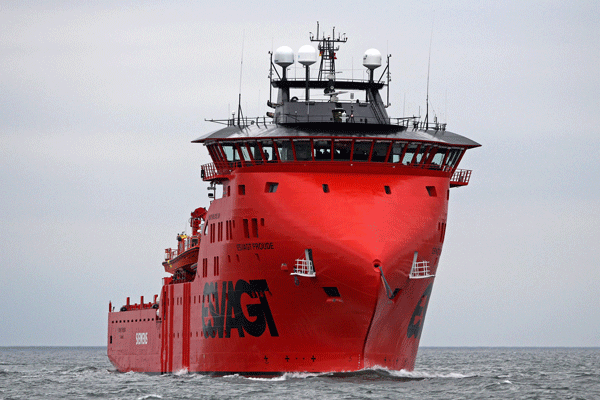Christening of the wind industry’s first SOVs

The Esvagt Froude was the first SOV to be formally christened
The Esvagt Froude was the first to be formally christened in Rostock. It will now support service and maintenance operations at EnBW’s Baltic II wind farm in the Baltic Sea. Two days later, the Esvagt Faraday was named in Hamburg. It will be deployed for servicing wpd’s Butendiek wind farm in the North Sea. Each of the vessels is 83.7m long, 17.6m wide and has a draught of 6.5m.
Chartered by Siemens and designed in close collaboration with Siemens’ Maritime and Aviation Solutions department, the SOVs are said to increase productivity, accelerate response times, and implement advanced safety mechanisms that will allow turbine access in significant wave heights of up to 2.5m.
As new generations of wind farms are located farther from shore, the need is growing for smart, predictive maintenance planning and new approaches for safely providing service and maintenance in more challenging weather conditions, especially in winter months when wind power yield can be high, Siemens noted.
One of the cornerstones of Siemens’ current approach is the company’s advanced remote diagnostics and monitoring, which can remotely solve up to 85% of alarms. When physical service is required, Siemens engineers are able to analyse the data gathered to accurately predict specific needed repairs before they become serious issues and proactively take action.
According to Siemens, this is the first time in the industry that this new type of vessel specifically engineered to service and maintain wind power plants far from shore is designed and commissioned.
With a large onboard storage area and comfortable accommodations, 40 Siemens’ technicians will live and work on the SOVs near the wind farm for several weeks, significantly reducing the time traveling to and from the wind turbines, the company said. The motion-sensored Ampelmann hydraulic access system on the SOVs will contribute to increasing the working window impacted by weather by enabling technicians to safely “walk to work” in the turbines at higher wave heights, it added. As the SOV can stay in the field for several weeks, it only needs to return to port for fueling and the replenishment of supplies and equipment.
In addition to being the end user of the SOV for offshore wind service purposes, Siemens also was a supplier to Esvagt AS for two key systems aboard the vessel. The Siemens BlueDrive™ propulsion system helps reduce CO2 emissions and fuel consumption, and Siemens hydraulics are used in the Ampelmann active access gangway system.
Siemens has also signed a chartering agreement with ship owner, Bernhard Schulte, for two Ulstein SX175 SOVs to be purpose-built for the long-term service and maintenance operations of the Gemini and Sandbank/Dan Tysk offshore wind power plants in the North Sea.
